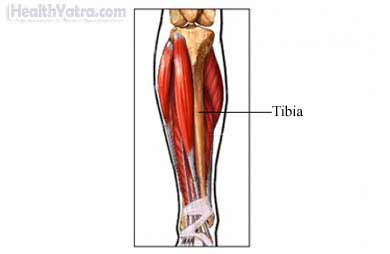تعريف
A shin splint is inflammation and pain along the inner part of the lower leg. It involves the tibia (shin bone).
أسباب
Shin splints occur when the tissue that connects muscles to the lining of the tibia becomes irritated and inflamed.

عوامل الخطر
A risk factor is something that increases your chance of getting a disease or condition. Risk factors for a shin splint include:
- Improper stretching or failure to warm up before exercising
- Activities that involve repeated pounding of the legs on hard surfaces (such as running, basketball, or tennis)
- Increasing intensity of exercise or mileage of running without proper preparation and conditioning
- Worn-out or ill-fitting footwear
- Improper running technique or problems with the way the foot hits the ground when running
- A strength imbalance between two opposing muscle groups in the leg
- Flattened foot arches
- Running on a slope
الأعراض
Symptoms of a shin splint include:
- Pain on the inner side of the shin, described as aching or throbbing with local tenderness
- Swelling or redness of the shin (possible, but not common)
التشخيص
If you have the symptoms of shin splints, you may not need to see a doctor. If the injury does not respond to self-treatment (see Treatments below) after two to four weeks, see your doctor. You may have a more serious injury.
The doctor will examine your الأسفل من الساق and look for areas of tenderness and swelling. In addition, the doctor will look for foot problems such as over-pronation. You may have an x-ray to check for a stress fracture, which has similar symptoms.
العلاج
RICE therapy
- Rest—Take a break from the activity that caused the pain. This is often enough to clear up the shin splint within a 10-day period.
- Ice—Apply ice in 15-minute periods during the first 24 hours after the injury and for several days after if needed. This helps reduce swelling, inflammation, and pain.
- Compression—Wrap the shin in an elastic bandage. This will help stop swelling and provide support for the shin and nearby soft tissues.
- Elevation—Keep the injured leg raised for the first 24 hours, including during sleep. If there is local swelling, this may help.
If you continue to have problems after you have initiated RICE therapy, ask your healthcare provider about alternating heat (15 minutes prior to exercise) and cold (15 minutes after exercise).
الدواء
In addition to RICE therapy, you may take anti-inflammatory medications to relieve pain.
Orthotics
If over-pronation is causing your shin splints, you can get custom-made arch supports, called orthotics, which help correct the over-pronation.
الوقاية
The following steps may help to prevent the development of a shin splint:
- Warm up gradually first and then do progressive stretching.
- Slowly increase intensity and duration of exercise.
- Cool down after exercise with light stretching.
- Run on a softer surface (such as grass, dirt, or certain outdoor tracks).
- Do not suddenly change from a softer running surface to a hard one.
- Carefully select footwear. Different shoes have different degrees of support and motion control.
- Avoid over-striding, which can put more stress on your shin.
- Wear orthotics if your doctor recommends them.
